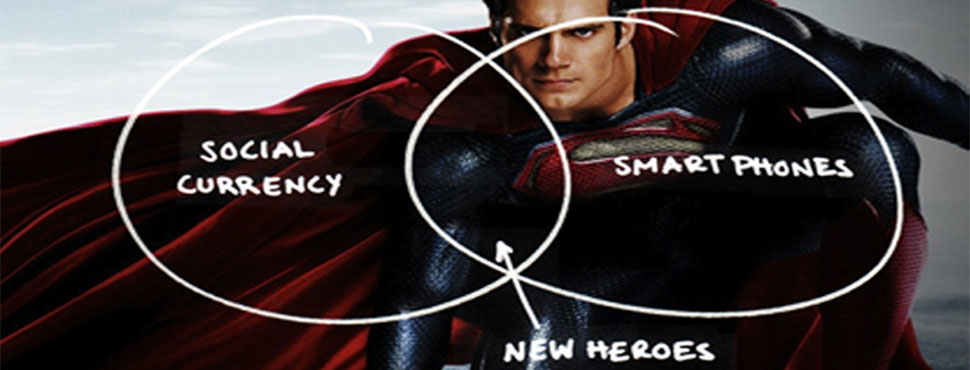“I know you’re trying to find out where I hang my cape. You won’t.” Superman, Man of Steel
It used to be the buyer’s journey resembled something like Dorothy’s trip to Oz: Follow the yellow brick road. These days that trek (or path-to-purchase) looks more like something out of Joseph Campbell’s hero’s journey, which powers the storylines of Star Wars, Superman andThe Matrix. It’s incredibly fragmented, and buyers have superpowers like the Web and smartphones. There are challenges to overcome along the way like social commerce, mobile commerce and even . And it’s almost impossible to know what each customer’s quest will look like when we aren’t even sure how they’re going to buy from us.
Of course, retailers are diving headfirst into data each day to better understand how their customer shops now and how they might shop in the future. What are they looking at? Here are a few trends that will help define the customer journey in 2014.
1. Our products will be on our doorstep before we knew we needed them. Did you know what I meant when I said “ambient commerce?” It’s the idea that the Internet of Things will keep us connected in such a way that our technology can simply signal to retailers when we need more toilet paper, eggs and diapers. It’s not just staples in your household, either. Our devices could signal a tow truck or order a new tire after a blowout, possibly before you’ve even put the donut on. They could order a car service when you land in an unfamiliar city or new running shoes when you exceed a certain mileage. To meet the customer along this journey, a brand or retailer must be integrated in their lives before the real need for them arises.
2. Online and offline retail environments will continue to blend into a single 24/7 experience. Many brick and mortar stores have closed their doors because of the epic retail shift online. That’s old news. But what has come of it is the synthesis of online and offline commerce. “It’s as dangerous to think of a bricks-and-mortar store as completely offline as it is to think of e-commerce as a separate part of your business,” said Erin Hunter, head of global CPG strategy at Facebook, in P2P. “Your consumer is online, and your consumer is online in your store.”
The customer journey can start and/or end in both places. Customers can order online and pick up in store. They can make their selection in-store and order online. This has led to traditionally online retailers like Amazon to open retail environments to cater to the customers who want to seamlessly move from online to offline. The customer journey can now start and end in any space at any time, and retailers need to be ready for this.
3. Our smartphones will become necessary shopping tools. We could never go shopping without our wallets. Cash, credit cards, and identification—it was (and pretty much still is) impossible to shop without these items. But now you can add smartphones to that list. Not only in the near future will they be able to replace our physical wallets and act as a digital wallet, but they also provide valuable information by providing access to competitive pricing, reviews, inventory and more. This access has resulted in new terms in our vernacular—showrooming, where customers browse in-store but buy online, sometimes while still in the store, and reverse-showrooming, where customers find the lowest prices online and bring that proof to their local retailer in hopes of matching the price and saving time and money on shipping. Like the idea of a 24/7 experience, the phone has fragmented the customer journey, requiring retailers to create a variety of solutions to prepare for customers that are online and offline simultaneously.
4. Retailers will weaponize our phones. The necessity of a smartphone to shop efficiently and effectively isn’t something retailers should fear. On the contrary, it’s a trend that can lead to innovation. Hointer, an experimental jeans shop in Palo Alto and Seattle, has built their store around their app. Customers learn about, try-on and purchase, all with the help of their smartphone. This not only makes the in-store customer journey interconnected, but it provides the retailer with precious data about which jeans are being tried on the most, which section the customers are looking at first, what sizes are most popular and lots more.
Retailers can also use the ubiquity of smartphones to provide customized offers through geofencing, drawing them into purchase as they move around the store. This adds suggestive selling into the customer journey, giving retailers more opportunity to guide them to the items they want sold.
5. Social currency will result in real currency. Every brand engaging on social channels wants to know how to optimize their social media efforts to drive purchase. Nordstrom did a fantastic job of this when it displayed its most pinned items (on Pinterest) both online and in their retail stores. Customers unsure of what style to buy could be swayed with the knowledge that Nordstrom’s Pinterest followers loved those specific items the most. It’s social currency at its best—driving purchase—and creates yet another avenue along the customer journey.
Jon Thomas is a senior digital Strategist at TracyLocke and frequent contributor to Say Daily. Follow him on Twitter @Story_Jon.
Originally posted January 27 Cream Global

